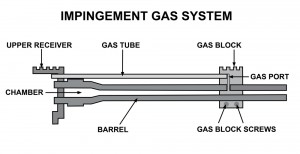At GunDigest, we independently review products. However, we may earn a commission when you purchase through links on our site. Learn More
6 Facts About AR-15 Direct Impingement Vs. Gas Piston
Some say the gas impingement operating system “poops where it eats”. But is that really fair? Here are Richard Mann's 6 factual observations in the AR-15 direct impingement vs. gas piston debate.

As someone who tests and reviews guns for a variety of firearms periodicals, I’ve had the opportunity to test versions of both the gas impingement and piston-driven ARs. Here are my factual discoveries:
1. Piston-driven guns run much cleaner. Fire a 30-round magazine through a piston-driven AR and it will look just as clean afterwards as it did before you fired it.
2. Piston-driven guns run much cooler. You’ll have to shoot about 100 rounds through a piston gun and a gas gun to really feel the difference, but it is there.
3. On average, piston-driven guns are less accurate. This does not mean piston-driven ARs are inaccurate, but, looking over my test records, the most accurate ARs I’ve tested have been those that work with the gas impingement system.
4. On average, piston-driven guns cost more. This observation must be qualified with “it depends.” There are some very expensive gas impingement ARs and some piston-driven ARs that are not all that expensive. However, if you want to purchase the least expensive AR possible, it will be a gas impingement gun.
5. If you intend to run a suppressor on your AR, it has been my experience that the gas impingement guns are more suppressor-friendly, especially those with an adjustable gas block that allows you to control the amount of gas directed back through the gas tube.
6. Both piston-driven and gas impingement guns are very reliable. If, by magic, you inserted me in the pages of Bryce Towsley’s book The 14th Reinstated and I had to live through a social and economic collapse where there were roving bands of marauders, and if you told me I had to pick between a gas impingement or a piston-driven AR, I really would not care which one I ended up with. Except for three things: parts for gas impingement ARs are easier to find, much more plentiful, and less expensive.
Now, here’s the good news. The unmatched modularity of the AR allows you to, in a way, have your cake and eat it, too. If you own a gas impingement AR and want to try a piston-driven AR, just purchase a piston-driven upper receiver. Since the gas impingement and piston systems work independently of the lower receiver, you can alternate between both on the same lower receiver.
Get On Target With More AR-15 Knowledge
- Top AR-15 Rifles – Options For Any Budget
- AR-10 vs AR-15 Comparison – How Stoner’s Rifles Stack Up
- Top AR-15 Upgrades – The Best Parts & Accessories
- How To Install AR-15 Lower Parts
- How an AR-15 Upper Works
- Buyer's Guide: Best AR Pistol Brace
- AR Pistol Buyers Guide – Best Options for Any Budget
- What Caliber is Best for AR-15
Next Step: Get your FREE Printable Target Pack
Enhance your shooting precision with our 62 MOA Targets, perfect for rifles and handguns. Crafted in collaboration with Storm Tactical for accuracy and versatility.
Subscribe to the Gun Digest email newsletter and get your downloadable target pack sent straight to your inbox. Stay updated with the latest firearms info in the industry.